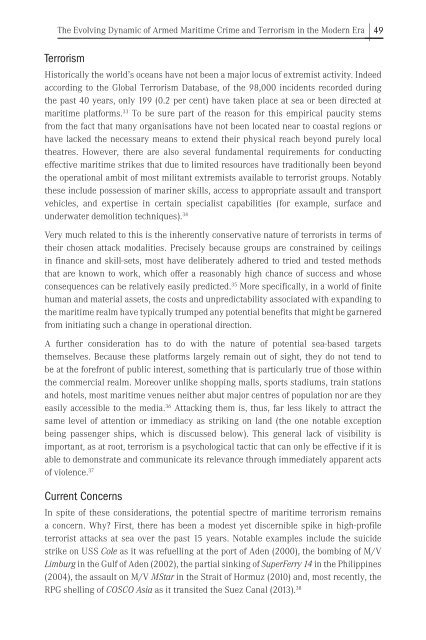THE FUTURE OF SEA POWER
SPC2015_Proceedings
SPC2015_Proceedings
Create successful ePaper yourself
Turn your PDF publications into a flip-book with our unique Google optimized e-Paper software.
The Evolving Dynamic of Armed Maritime Crime and Terrorism in the Modern Era | 49<br />
Terrorism<br />
Historically the world’s oceans have not been a major locus of extremist activity. Indeed<br />
according to the Global Terrorism Database, of the 98,000 incidents recorded during<br />
the past 40 years, only 199 (0.2 per cent) have taken place at sea or been directed at<br />
maritime platforms. 33 To be sure part of the reason for this empirical paucity stems<br />
from the fact that many organisations have not been located near to coastal regions or<br />
have lacked the necessary means to extend their physical reach beyond purely local<br />
theatres. However, there are also several fundamental requirements for conducting<br />
effective maritime strikes that due to limited resources have traditionally been beyond<br />
the operational ambit of most militant extremists available to terrorist groups. Notably<br />
these include possession of mariner skills, access to appropriate assault and transport<br />
vehicles, and expertise in certain specialist capabilities (for example, surface and<br />
underwater demolition techniques). 34<br />
Very much related to this is the inherently conservative nature of terrorists in terms of<br />
their chosen attack modalities. Precisely because groups are constrained by ceilings<br />
in finance and skill-sets, most have deliberately adhered to tried and tested methods<br />
that are known to work, which offer a reasonably high chance of success and whose<br />
consequences can be relatively easily predicted. 35 More specifically, in a world of finite<br />
human and material assets, the costs and unpredictability associated with expanding to<br />
the maritime realm have typically trumped any potential benefits that might be garnered<br />
from initiating such a change in operational direction.<br />
A further consideration has to do with the nature of potential sea-based targets<br />
themselves. Because these platforms largely remain out of sight, they do not tend to<br />
be at the forefront of public interest, something that is particularly true of those within<br />
the commercial realm. Moreover unlike shopping malls, sports stadiums, train stations<br />
and hotels, most maritime venues neither abut major centres of population nor are they<br />
easily accessible to the media. 36 Attacking them is, thus, far less likely to attract the<br />
same level of attention or immediacy as striking on land (the one notable exception<br />
being passenger ships, which is discussed below). This general lack of visibility is<br />
important, as at root, terrorism is a psychological tactic that can only be effective if it is<br />
able to demonstrate and communicate its relevance through immediately apparent acts<br />
of violence. 37<br />
Current Concerns<br />
In spite of these considerations, the potential spectre of maritime terrorism remains<br />
a concern. Why? First, there has been a modest yet discernible spike in high-profile<br />
terrorist attacks at sea over the past 15 years. Notable examples include the suicide<br />
strike on USS Cole as it was refuelling at the port of Aden (2000), the bombing of M/V<br />
Limburg in the Gulf of Aden (2002), the partial sinking of SuperFerry 14 in the Philippines<br />
(2004), the assault on M/V MStar in the Strait of Hormuz (2010) and, most recently, the<br />
RPG shelling of COSCO Asia as it transited the Suez Canal (2013). 38


